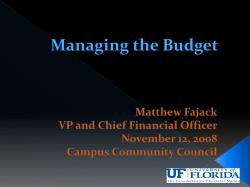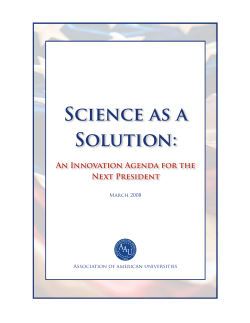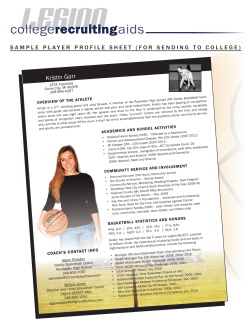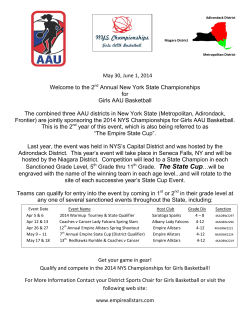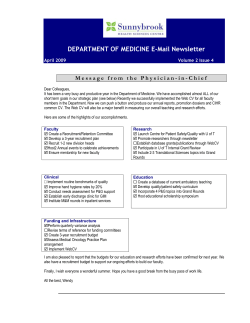
Document 1684
MAY Examining the AAU Gatekeepers May 11,2011 MU mention page 3 When the Association of American Universities voted in April to strip the University of Nebraska at Lincoln of its membership, it was the first time in the organization's Ill-year history that members had so blatantly turned on one of their own, an event widely described as "unprecedented." The question now is whether it will be repeated. The vote to kick out Nebraska, and to nudge out Syracuse University, which chose to leave the AAU, followed a quiet rethinking of the organization's membership: it no longer comes with a Iifetime guarantee. For the 60 remaining members, especially those who superficially resemble Nebraska or Syracuse, this might be a reason to look over their shoulders. Officials at many such universities say they are confident that they perform well in the metrics AAU uses to assess candidates as well as evaluate members and, increasingly, determine whether they will retain their place in the group. Still, most are also taking steps to shore up their research performance, often through strategic plans that were already in place before the membership vote last month. At the same time, the departures have rekindled debate about the AAU's ranking methodology and whether membership in the elite group has been given too much weight. "Universities are prestige-maximizing entities," said Ronald Ehrenberg, a professor of labor relations and economics at Cornell University who has written extensively on the role of higher education. "But I think you sort of have to ask: At what price prestige?" The AAU evaluates its members based on five major criteria: research expenditures normalized by number offaculty, National Academy members, the National Research Council faculty quality indicators, a selection of faculty honors, and scholarly citations. By those markings, Nebraska had been on shaky ground within the AAU for more than a decade. The medical school for the University of Nebraska system is not affiliated with the flagship campus in Lincoln, meaning that research dollars from the National Institutes of Health do not count in its overall expenditures. The university'S land-grant mission means it conducts a significant amount of agricultural research -- federal funding for which is given much less weight in the association's rankings. «rn Should the AAU continue to cull its members, universities with similar profiles might be considered the most vulnerable, but the shock waves from Nebraska's ouster and Syracuse's decision to leave extend beyond the few members that look like them. "For all of the universities in AAU that are not at the very top. it raises the question of what will eventually be their vulnerability," University of Kansas Chancellor Bernadette Gray-Little said. Too Big to Succeed? In the days following Nebraska's ouster, Chancellor Harvey Perlman argued that the vote was part of a larger push within AAU to make the organization smaller and more elite. Though the association's membership remains diverse, including both public institutions and wealthy private universities of varying sizes, it is unclear whether the association will reach out to replace the two departing members. A bigger membership means more clout on Capitol Hill, presuming that institutions come from a wide range of states. (More than one observer noted that in dumping Nebraska, the AAU might have lost the support of2 of 100 U.S. senators.) But it could also get unwieldy. Of the national higher education organizations, AAU is among the smallest, which some members say is one of its strengths. As the number of universities focusing on research has expanded since the 1970s, with research paid for by the National Institutes of Health increasing especially, more institutions have been able to argue that they deserve membership, said Irwin Feller, a professor emeritus of economics at Pennsylvania State University who studies science and technology policy and the economics of higher education. "There will always be some institutions whose credentials are at least as good as the last member" of the association, he said. For Rice University, one of the smallest institutions in the AAU, the diversity of membership - including both huge public universities and private institutions known for work outside the sciences -- is important, President David Leebron said. But so is the group's small size, he said, describing the association as an "intimate environment" in which members can easily reach out to each other and the group's leaders. "It works a certain way because of its size," he said. "11' it were much larger than it is now, it would probably function in a substantially different way." Counting and Dividing One factor that keeps the AAU membership more diverse than it otherwise might be is the normalization process, which measures research funding per faculty member (rather than in raw dollars over all for the institution). Some universities that appear to be outliers, with relatively small levels of federal spending, might in fact be secure in their membership after the numbers are normalized. Rice, which received $55 million in federal research money in 2008, ranks far below most of its fellow members in that figure alone. But the university'S small size, with 650 total full-time faculty, plays in its favor, Lecbron said. "Wc feel pretty comfortable on the criteria that says it's something about the quality and intensity of research in the university, not the total research dollars," he said. Another beneficiary is Brandeis University, which with only $38 million in federal spending in 2008 might appear among the most vulnerable institutions. "I think we certainly belong in the AAU," President Frederick Lawrence said. "The norming to the size of the school is so important. That, to me, is the best answer to the argument that the !\AU is monolithic." For institutions like Nebraska, though, normalization has drawbacks. Administrators there argued that counting agriculture faculty for normalization purposes but discounting research money awarded through the Agriculture Department in the initial criteria was a one-two punch that put the university at a disadvantage. A former president of a public AAU institution who requested anonymity in discussing the association said that normalization could discourage universities from adding faculty who focus on teaching rather than research, and stem expansion at a time when there is a growing emphasis on increasing the country's graduation rates, The same could be said for faculty members who work in fields less likely to attract research money. "If you're trying to get in to the AAU and you have a choice between a faculty member that produces outside dollars, vcrs us a humanities professor that almost certainly would not, you shouldn't hire the humanities professor," the former president said. "Now you know what the criteria l are J generally, will you grow in students for areas in which you're unlikely to get outside research dollars?" Others said that scenario was far-fetched. While universities arc not above making moves to benefit their standing in various rankings, whether the AAU's or those in U.S. News and World Report, focusing on a medical school at the expense of an engineering school or the liberal arts is "such a large change," Feller said. "Maybe there arc universities that do this over time, but it has to be tied into a larger vision." The Value of Agriculture In compiling its rankings, the AAU gives more weight to competitively awarded federal grants, such as those through the NIH or National Science Foundation, than to funding from the USDA, which is awarded by formula. Nebraska's ejection has revived a long-simmering debate over whether that is the correct approach. Recipients of Agriculture Department funding aren't hayseeds or inferior scientists, administrators of land-grant universities argue. They are academic researchers whose work helps combat hunger and contributes to scientific advances across a broad range of disciplines. Some are pushing for the association to reconsider the weight it gives to agricultural research spending. "Have we effectively recognized the power of the research that has been undertaken by first-rate scientists that come from that strong agricultural research base?" asked Bradv Deaton, chancellor of the University of Missouri at Columbia. "We have to make sure that we're properly evaluating. From an AAU perspective, we've got somc work to do there so that it properly reflects the strength of American higher education." Agricultural funding is awarded by formula for reasons that extend beyond the political. he said. Spreading the money out across the nation ensures that every agricultural zone is taken into account; plant research in Oregon would have different outcomes from plant research in Oklahoma. "These are first-rate scientists in our land-grant universities," Deaton said. "Those funds are financing the salaries and the time commitments of our first-rate researchers." He suggested that the association might take the output of agricultural research into account, such as articles published in peer-reviewed journals. The discussion is continuing, and while it might not reach a resolution, he predicted that the landscape would look different in 10 years. "We've got to continue to examine alternate measures," he said. "We've got to ensure we have adequate time to discuss what counts and what doesn't. and whether or not we're really addressing the issues." Measuring Excellence In leaving the AAU, Syracuse might have jumped because it was about to be pushed. But it drew praise from Feller and Ehrenberg, the experts on the economics of higher education, for choosing to focus on what it does well rather than what the AAU thinks it should do. "It is sort of amusing that these institutions are becoming more homogeneous. becoming more uniform, as opposed to sort of creating unique, new niches," Ehrenberg said of research universities. "Wc can't all be everything to everyone. We have to sort of appreciate the special strengths." An increasing number of universities are qualified, and not all of them will ever make the cut. "It's just not possible to have 50 universities make it into the top I0," Feller said. The question, he added, is whether institutions will tind other ways to judge quality on their own terms. Leebron, the Rice president who would like to see the organization remain smal I. said that while there was no "magic number" for the ideal size, some universities will remain, or become, stellar institutions without the coveted badge of membership. "We all ought to recognize that the more great research universities there are in the U.S., the better off we are as a country," he said. "It might not be that all of them are members of the AAU .... That doesn't diminish the good work that they carryon." - Libby A. Nelson Parsley Contains Breast Cancer-Fighting Compound Published May 10,2011 I FoxNews.com Parsley is usually found sprinkled on your dinner plate as a pretty garnish, but this popular herb can be used for a lot more than that. In fact, it could help stop certain breast cancer tumor cells from multiplying and growing, according to researchers at the University of Missouri. In a new study, the researchers exposed rats - with a certain type of breast cancer - to a common compound called apigenin, which is found in parsley and in other plant products, including fruits and nuts. They found the rats that were exposed to this compound developed fewer tumors, and in addition, experienced a "significant delay" in tumor formation compared to rats who were not exposed to the compound. "It appears that keeping a minimal level of apigenin in the bloodstream is important to delay the onset of breast cancer that progresses in response to progestins such as medroxyprogesterone acetate (MPA)," Salman Hyder, the Zalk Endowed Professor in Tumor Angiogenesis and professor of biomedical sciences in the College of Veterinary Medicine and the Dalton Cardiovascular Research Center, said in a news release. "It's probably a good idea to eat a little parsley and some fruit every day to ensure the minimal amount. However, you can also find this compound in pill supplements in the health food section of many stores. Of course, you should always check with your doctor before making any major changes to your diet or lifestyle." Apigenin is most prevalent in parsley and celery, but can also be found in apples, oranges, nuts and other plant products. However, Hyder said this compound is not absorbed into the bloodstream efficiently, so he believes further studies on humans is necessary to determine a specific dosage. Researchers believe these findings could also impact women on certain hormone replacement therapies. The study was published recently in Cancer Prevention Research. COLlJMBIA MISSOlTRIAN Doggie Play Day raises funds to aid wild tigers By Caitlyn Crawford May 10, ;'f't" 2011 14:46 .m. CDT ~~\: "~">- ,r" ,,':';p MU freshmen Nicole Twaddle, left, Angela Garcia, back, and Stephanie Gelhot play with dogs from Columbia Second Chance at the Doggie Play Day fund raiser. They heard about the event through Facebook and decided to come play with the dogs for a study break. : Christie Megura COLUMBIA - Fifteen minutes with man's best friend could help save a life - the life of a wild tiger. From 11 a.m. to 3 p.m. Tuesday students gathered at MU's Tiger Plaza to play with a furry friend of their choice in the second annual Doggie Play Day. The going price was $3 for 15 minutes. The event was hosted by Mizzou Tigers for Tigers, a student-led conservation program that works toward wild tiger conservation through donations and education. "I don't think people realize how few tigers are left in the wild and that there are ways they can help," said Jennifer Smith, president of Mizzou Tigers for Tigers. In addition to wild tigers, proceeds also went to Second Chance Animal Rescue, which provided the 18 adoptable dogs for people to play with. "The dogs get a chance to get out and interact with people," Smith said. "The students also get a chance to relax between finals and enjoy the company of the dogs." Valerie Chaffin, a volunteer at Second Chance, said the event is worthwhile because it shows the public that shelter dogs aren't unhealthy, aggressive or mean. "These are happy, healthy dogs who just need a home," Chaffin said. When the event started, there were more people than dogs. But Chaffin said she didn't think the dogs minded being fought over. "These dogs are getting five hours of exercise and love," she said. "They're going to sleep good tonight." Two sister pooches, Eliza and Harriet, Pekingese and Chihuahua mixes, were a big hit with attendees. Freshman Sabrina Marshall sat in the grass with floppy-eared Harriet while sophomore Lauren Crist spent her 15 minutes with Eliza. "I've gotten eight hours of sleep in the last two days for my finals today," Crist said. "So this is a great way for me to relax, even if it's just for a little bit. I think $3 is completely worth it." Freshman Kaitlin Bereswill played with a black lab puppy named Bootsie. "This is my half-way-through break I'm giving myself for my five finals," Bereswill said. "It's a major stress reliever." Smith said 55 people participated in the event last year, which generated $200 in donations. This year's totals jumped to 85 people with $280 in donations. COLUMBIA NIISSOURIAN MU museum director named to federal committee By Rachel Stinebring May 10, 2011 I 7:51 p.m. CDT COLUMBIA- Secretary ofthe Interior Ken Salazar recently named Alexander Barker, director of MU's Museum of Art and Archaeology, to the Native American Graves Protection and Repatriation Committee. Created in 1990, the committee is a companion to the Native American Graves Protection and Repatriation Act. According to the National Parks Service's website, the act "provides a process for museums and Federal agencies to return certain Native American cultural items ... to lineal descendants, and culturally affiliated Indian tribes and Native Hawaiian organizations." These items include human remains, funerary objects and sacred objects. In addition, objects of cultural patrimony or objects of importance to an entire community, rather than to one individual, are included in the act. Barker said the committee ensures that museums and tribes resolve repatriation issues in accordance with the law. The committee consists of three scholars, three members of native tribes and a member at large who serves for four years. Four times a year, the committee meets to discuss the ownership of cultural property. "The trick is deciding what belongs to whom," Barker said. "These are not necessarily clear issues because archaeological and tribal arguments are two radically different kinds of evidence." Barker said that the review process provides an opportunity for all stakeholders to discuss the cultural property in a public forum. "There are many stakeholders - tribes, museums, private entities like corporations that are involved," Barker said. "There's a perception that all of their interests differ; I hope they don't." Barker said he will pull from his experience at MU when serving on the committee. "This is a working museum," Barker said. "We are involved with issues of cultural property all the time. It just informs what I do here." Barker previously worked as vice president for collections and research at the Milwaukee Public Museum and has served as field director for numerous archaeological projects across the U.S. Barker said he is excited to explore issues of cultural property on a national level. "Ultimately, this committee is about who owns the past and trying to figure out a fair way to balance competing claims," Barker said. "These are the issues that make history." ~X\\BU5INE55 THE POWER TO PROSPER'" Are credit cards addictive? By Jim Sloan Published May 09, 2011 The Great Recession has many people pinching pennies, cancelling ski vacations and squirreling money away in emergency funds. But the fact is that despite high unemployment, shrinking retirement accounts and the collapse of the housing market, many of us are still buying stuff with our credit cards. Lots of stuff. The nation's credit card debt now tops $800 billion--or about $9,000 per household with a credit carel. And although the Federal Reserve Bank reports that the numher of credit card accounts has declined since 2008, we're still putting more than $1.9 trillion a year on OUf cretin cards. What's driving it? Well, it could be a sign that the economy is improving and people are showing a willingness to spend again. That's how some economists see it. It could also be that people are turning to their credit cards to make ends meet, and that doesn't bode "ell for them or the economy. According to the Washington State J)JCl'.grtment of Financial Institutions, ahout 40 percent of Americans say they arc living beyond their means. But recent research suggests that rampant credit card use could be a sign of much more complex issues. And we're not talking about economic issues. We're talking about psychological issues. The emotions of shopping A study by Dr. Marsha Richens, a business professor at the University of Missouri, found that manv people who overuse their credit cards and accumulate massive amounts of credit card debt are often buving things for emotional reasons. They hope that the things they arc buying will make them happier, more popular or better equipped to succeed in life. Richins said that some credit card overusers believe that their purchases can deliver a magical transformation in their lives. Unfortunately, those changes are often fleeting, and "hen they quickly fade. the shoppers find themselves out on another spree. Sort of like a drug addict looking for another fix. "For many of the people we studied who overuse their credit cards, making purchases was exciting. When they talk ahout buying things, their faces light up," Richins said. "These were people who expect magic to happen to them when they buy things." Suffering from "debtors' disease" Carol, a costume designer in Portland. Ore .. knows that feeling well, While living in Southern California, she racked up more than $20,000 in credit card debt before she realized she "as spending so much simply hecause it made her feel good. "I had a compulsion." said Carol, whose last name is being withheld because she participates in a group called Debtors Anonymous, which fiercely protects its members' identifies. "There was something inside me--this little attitudc-vthat said I could have whatever I wanted whenever I wanted it. I call it the debtors disease." In Carol's case, buying things with her credit card gave her a sense of great self-worth. She says she felt "like an adult, like a real business person." What people get out of huying That attitude is similar to what Richins found in studying people who overuse their credit cards. She found there were four types of transformations people expected: • • • • Self improvement, such as the woman who believed spending money on cosmetic dental work would make her more confident and popular. Improved relationships, such as the father who was certain buying a built-in swimming pool would improve his relationship with his daughter. A newfound sense of adventure--what Richins calls "hedonic transformation"--such as the expectation of wild fun that might come from buying an ATV or a sailboat Greater effectiveness, which is what some buyers might expect from buying an expensive new computer tablet or even a new car. Richins' research is groundbreaking in that it scientifically documents how credit card overusers actually have different beliefs about the products they buy than people who stay within their budget. But it's not as though the emotional urges of credit card users is news to the people who market credit cards. "The ads you see all but promise the kind oftransforrnations thai people are looking for," Richins said. "They show the father taking his son to the baseball game and buying food and souvenirs and they add up the cost of everything and then tell you that, sure, those things cost money but the improved relationship you'll have with your son is priceless. They are appealing directly to the type of person who tends to overuse their credit card." Hard-wired to love new things Richins has been studying materialism for more than two decades, and she believes humans are "hard-wired" to want new things that make life better. Primitive people who had better tools survived. so they passed along an innate sense of attraction to things that make survival--life--easier. Most people, though, come to realize that some tools are important and 01 her lools are just a waste of money. They learn that some tools won't make them happier, or more popular or closer to loved ones. Other people don't make that realization. "Wanting new things isn't a bad thing," she says, "but when stuff owns us instead of the other way around, there's a problem. II Where to get help Carol learned that the hard way. It took her II years after she cut up her credit cards to payoff all the debt she had accumulated. She went to a lot of sessions of Debtors Anonymous. which is a 12-step program similar to Alcoholics Anonymous in which participants look to a spiritual power to help control their damaging tendencies. She still goes, and recommends people who want help go to www.debtorsanonymous.org and type in their ZIP code to find a meeting near them. And until that starts to work, she tells people to put their credit cards in a plastic bag filled with water and put the bag in the freezer. Next time you want to put something on your card, you'll have to wait until it thaws- and that might be just enough time to think it over and realize you don't really need to buy that thing after all. Ap Associated Press Domestic Violence Trial Set for Former Mizzou RB COLUMBIA, Mo. (AP) - The first of two trials for former University of Missouri running back and co-captain Derrick Washington is set for Wednesday afternoon. Washington is scheduled to appear in a Boone County courtroom on two misdemeanor charges of domestic violence. An ex-girlfriend said Washington poked her eyes and choked her during an argument last September. She later told prosecutors Washington had previously assaulted her at least seven times. Washington faces a separate trial in late June on a felony sexual assault charge involving a former Missouri athletics tutor. He has pleaded not guilty in both cases. Washington was Missouri's leading rusher in 2008 and 2009. After he was charged last year, coach Gary Pinke! initially suspended him but then dismissed him from the team on the eve of the 20 I0 season.
© Copyright 2025




